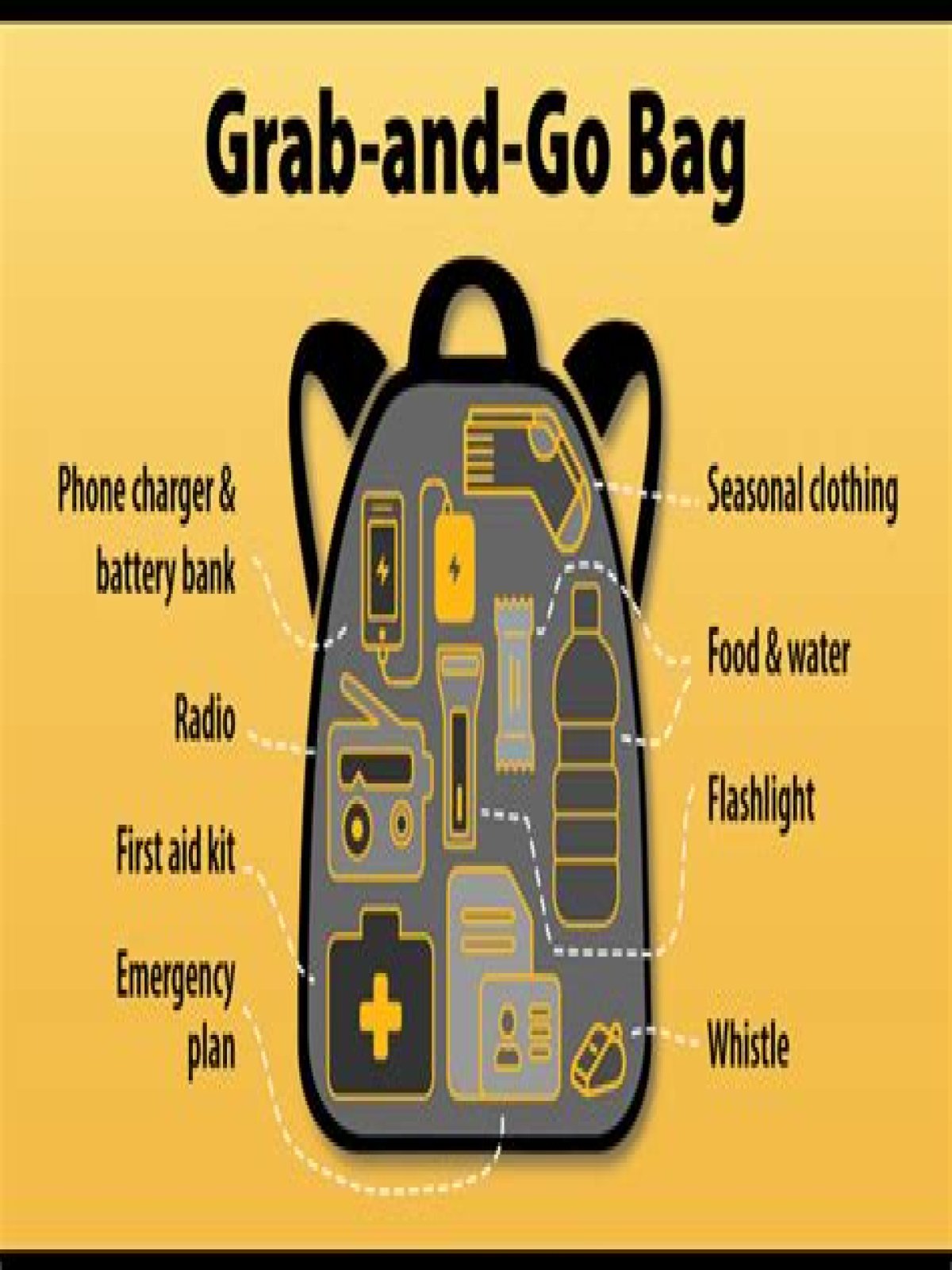- Food (ready to eat) and water.
- Phone charger and battery bank.
- Small battery-powered or hand-crank radio.
- Battery-powered or hand-crank flashlight.
- Extra batteries.
- Small first-aid kit and personal medications.
- Personal toiletries and items, such as an extra pair of glasses or contact lenses.
Then, what do you put in a grab and go bag?
An emergency preparedness kit needs to include food and water for each member of your family for three days, a battery-powered or hand-crank radio, flashlight, spare batteries, first aid kit, can opener, local maps, moist towelettes, toilet paper, garbage bags and plastic ties for personal sanitation.
Beside above, what is inside the go bag? The Go Bag contains your personal emergency supplies pre-packed in an easy-to-carry solution, usually a sturdy backpack. In addition to essential survival supplies you should pack personal items such as medication, maps, keys, spare glasses, copies of documents and other important records.
Keeping this in view, what should be in your emergency bag?
A basic emergency supply kit could include the following recommended items:
- Water - one gallon of water per person per day for at least three days, for drinking and sanitation.
- Food - at least a three-day supply of non-perishable food.
- Battery-powered or hand crank radio and a NOAA Weather Radio with tone alert.
- Flashlight.
How do you make a grab and go bag?
Here's how to prepare a evacuation “go bag” that you can quickly grab in case you ever need to evacuate.
- Choose a bag.
- Take photos of all the rooms in your home, along with all your valuables.
- Scan all your important documents, and save them on a flash drive.
- Add essential supplies to help you get by for a few days.
What should I put in a survival bag?
- Water: one gallon per person, per day (3-day supply for evacuation, 2-week supply for home)
- Food: non-perishable, easy-to-prepare items (3-day supply for evacuation, 2-week supply for home)
- Flashlight.
- Battery-powered or hand-crank radio (NOAA Weather Radio, if possible)
What should be in a 72 hour kit?
- Water, one gallon of water per person, per day, for at least three days. (
- Food, at least a three-day supply of non-perishable food.
- Battery-powered or hand-crank radio and a NOAA Weather Radio with tone alert and extra batteries for both.
- Flashlight and extra batteries.
- First aid kit.
What is in an inch bag?
How much cash should I have in my emergency kit?
How do you prepare for an emergency situation?
- Make a communications plan. Know where to meet and how to communicate with family and friends.
- Prepare to evacuate your home. Review and practice escape routes.
- Get your vehicle ready.
- Create an emergency supply kit.
- Consider special needs.
What are 10 items in a first aid kit?
- Gloves/Eye Protection.
- CPR Pocket Mask.
- Tourniquet.
- Roller Gauze.
- 4×4 Gauze Pads.
- Medical Tape.
- Two Triangular Bandages.
- Sam Splint.
What is the best go bag?
- Mystery Ranch 3 Day Assault Pack.
- The 4 Person Survival Kit Deluxe (Ideal for Earthquakes & other natural disasters) By Survival Prep Warehouse.
- GoRuck GR1 Tactical Backpack (26L)
- 5.11 Tactical Rush 72 Backpack.
- Condor 3 Day Assault Pack.
- Eberlestock Skycrane II.
- Maxpedition Vulture-II Backpack.
- Red Rock Large Assault Pack.
What goes in a 72 hour emergency kit?
- Water (at least one gallon per person, per day)
- Food (more on this below)
- Battery-powered or hand-powered radio and extra batteries.
- High-powered flashlight.
- First aid kit.
- Whistle (to signal for help)
How much food should I store for an emergency?
What is the best emergency survival kit?
- Emergency Zone Urban Survival Bug Out Bag.
- Survival Prep Warehouse 2 Person Deluxe Survival Kit.
- Sustain Supply Company Essential 2.
- Red Cross Basic 3-Day Emergency Kit.
- Sustain Supply Company Comfort 2.
- Survive Outdoors Longer Urban Survivor.
Where should emergency supplies be stored?
What items should be in a first aid kit?
- plasters in a variety of different sizes and shapes.
- small, medium and large sterile gauze dressings.
- at least 2 sterile eye dressings.
- triangular bandages.
- crêpe rolled bandages.
- safety pins.
- disposable sterile gloves.
- tweezers.
